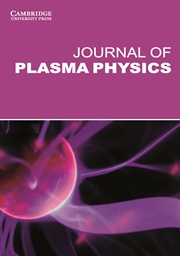Crossref Citations
This article has been cited by the following publications. This list is generated based on data provided by
Crossref.
Bousselin, G.
Plihon, N.
Lemoine, N.
Cavalier, J.
and
Heuraux, S.
2015.
How plasma parameters fluctuations influence emissive probe measurements.
Physics of Plasmas,
Vol. 22,
Issue. 5,
Rafalskyi, D.
and
Aanesland, A.
2015.
Plasma acceleration using a radio frequency self-bias effect.
Physics of Plasmas,
Vol. 22,
Issue. 6,
Melville, Scott
Schekochihin, Alexander A.
and
Kunz, Matthew W.
2016.
Pressure-anisotropy-driven microturbulence and magnetic-field evolution in shearing, collisionless plasma.
Monthly Notices of the Royal Astronomical Society,
Vol. 459,
Issue. 3,
p.
2701.
Cavalier, Jordan
Lemoine, Nicolas
Bousselin, Guillaume
Plihon, Nicolas
and
Ledig, Jordan
2017.
Strongly emissive plasma-facing material under space-charge limited regime: Application to emissive probes.
Physics of Plasmas,
Vol. 24,
Issue. 1,
Cortés-Domínguez, I.
and
Burguete, J.
2017.
Instabilities of conducting fluid layers in weak time-dependent magnetic fields.
Physical Review E,
Vol. 96,
Issue. 1,
Borisevich, V. D.
Potanin, E. P.
and
Whichello, J.
2017.
Circulation control in magnetohydrodynamic rotating flows.
Journal of Fluid Mechanics,
Vol. 829,
Issue. ,
p.
328.
Del Sarto, Daniele
and
Pegoraro, Francesco
2018.
Shear-induced pressure anisotropization and correlation with fluid vorticity in a low collisionality plasma.
Monthly Notices of the Royal Astronomical Society,
Vol. 475,
Issue. 1,
p.
181.
Rincon, François
2019.
Dynamo theories.
Journal of Plasma Physics,
Vol. 85,
Issue. 4,
Désangles, Victor
Bousselin, Guillaume
Poyé, Alexandre
and
Plihon, Nicolas
2021.
Rotation and shear control of a weakly magnetized plasma column using current injection by emissive electrodes.
Journal of Plasma Physics,
Vol. 87,
Issue. 3,
Trotabas, B
and
Gueroult, R
2022.
Trade-off in perpendicular electric field control using negatively biased emissive end-electrodes.
Plasma Sources Science and Technology,
Vol. 31,
Issue. 2,
p.
025001.
Vincent, Simon
Dolique, Vincent
and
Plihon, Nicolas
2022.
High-speed imaging of magnetized plasmas: When electron temperature matters.
Physics of Plasmas,
Vol. 29,
Issue. 3,
Vincent, Simon
Dolique, Vincent
and
Plihon, Nicolas
2023.
Nonlinear interactions of ion acoustic waves explored using fast imaging decompositions.
Physics of Plasmas,
Vol. 30,
Issue. 1,
Pagaud, F
Dolique, V
Claire, N
and
Plihon, N
2023.
Emissive cathode immersed in a plasma: plasma–cathode interactions, operation and stability.
Plasma Sources Science and Technology,
Vol. 32,
Issue. 11,
p.
115019.
Pagaud, F
Dolique, V
Vincent, S P H
Trotabas, B
Gueroult, R
and
Plihon, N
2025.
Plasma potential control in a magnetized plasma column using a thermionic cathode.
Plasma Sources Science and Technology,
Vol. 34,
Issue. 6,
p.
065012.

